#Assembly Program Solution
Explore tagged Tumblr posts
Text
When I was in vet school I went to this one lecture that I will never forget. Various clubs would have different guest lecturers come in to talk about relevant topics and since I was in the Wildlife Disease Association club I naturally attended all the wildlife and conservation discussions. Well on this particular occasion, the speakers started off telling us they had been working on a project involving the conservation of lemurs in Madagascar. Lemurs exist only in Madagascar, and they are in real trouble; they’re considered the most endangered group of mammals on Earth. This team of veterinarians was initially assembled to address threats to lemur health and work on conservation solutions to try and save as many lemur species from extinction as possible. As they explored the most present dangers to lemurs they found that although habitat loss was the primary problem for these vulnerable animals, predation by humans was a significant cause of losses as well. The vets realized it was crucial for the hunting of lemurs by native people to stop, but of course this is not so simple a problem.
The local Malagasy people are dealing with extreme poverty and food insecurity, with nearly half of children under five years old suffering from chronic malnutrition. The local people have always subsisted on hunting wildlife for food, and as Madagascar’s wildlife population declines, the people who rely on so-called bushmeat to survive are struggling more and more. People are literally starving.
Our conservation team thought about this a lot. They had initially intended to focus efforts on education but came to understand that this is not an issue arising from a lack of knowledge. For these people it is a question of survival. It doesn’t matter how many times a foreigner tells you not to eat an animal you’ve hunted your entire life, if your child is starving you are going to do everything in your power to keep your family alive.
So the vets changed course. Rather than focus efforts on simply teaching people about lemurs, they decided to try and use veterinary medicine to reduce the underlying issue of food insecurity. They supposed that if a reliable protein source could be introduced for the people who needed it, the dependence on meat from wildlife would greatly decrease. So they got to work establishing new flocks of chickens in the most at-risk communities, and also initiated an aggressive vaccination program for Newcastle disease (an infectious illness of poultry that is of particular concern in this area). They worked with over 600 households to ensure appropriate husbandry and vaccination for every flock, and soon found these communities were being transformed by the introduction of a steady protein source. Families with a healthy flock of chickens were far less likely to hunt wild animals like lemurs, and fewer kids went hungry. Thats what we call a win-win situation.
This chicken vaccine program became just one small part of an amazing conservation outreach initiative in Madagascar that puts local people at the center of everything they do. Helping these vulnerable communities of people helps similarly vulnerable wildlife, always. If we go into a country guns-blazing with that fire for conservation in our hearts and a plan to save native animals, we simply cannot ignore the humans who live around them. Doing so is counterintuitive to creating an effective plan because whether we recognize it or not, humans and animals are inextricably linked in many ways. A true conservation success story is one that doesn’t leave needy humans in its wake, and that is why I think this particular story has stuck with me for so long.
(Source 1)
(Source 2- cool video exploring this initiative from some folks involved)
(Source 3)
#we can save the world just maybe not in the way we’d planned#long post#scicomm#conservation#lemurs#wildlife#ecology#animals#vet med#veterinary medicine#One Health
36K notes
·
View notes
Text
useful information: How to get a USB Blu-Ray player to work on your computer
Not a post about vintage technology, just an explanation of what you think might be simple to do but isn't: There are Blu-Ray players that plug into your computer by USB, and you discover that just plugging it in doesn't make it work* in the same manner that CD-RWs or DVD-RWs are automatically recognised and function. You will see "BR Drive" in My Computer and the name of whatever movie you have inserted, but that's as far as you're able to go.

*There is software you can buy to make a Blu-Ray (internal or external) function, sure, and if an internal came with your computer it's likely already installed -- but if you're like me you don't have that software, you're cheap and won't pay for software, and you want to use what you have installed already or find free solutions.
Looking in the Blu-Ray drive's package, there's not a lot of info about what you're supposed to do. The above no-name Blu-Ray player cost $40 from a popular website; name-brand ones can set you back $120 or so. Looking around online for those instructions, I never saw the whole set of directions in one place, I had to cobble them together from 2 or 3 sites. And so here I share that list. To keep out of trouble, I'm not linking any files -- Google will help you.
Get VLC, the free video player available for pretty much any operating system. Thing is, it doesn't come with the internals to make it work with Blu-Ray even if when you go to the Play Media menu there is a radio button for selecting Blu-Ray.
Get MakeMKV, a decoder for reading Blu-Ray disks. This had been totally free during the beta testing period but it's come out and has a month or two trial period you can work in.
Get Java if you don't already have it. Reason for this is, the menu systems on Blu-Ray disks uses this... technically it's not required, however it does mean you don't have options such as special features, language and sound changes, or scene selection if you don't have Java installed; insert a disk, it can only play the movie.
Get the file libaacs.dll online so you have AACS decoding. I am told it hasn't been updated in awhile so there may be disks produced after 2013 that won't work right, but you won't know until you try.
There's a set of keys you will also want to have so that the player knows how to work with specific disks, and so do a search online for the "FindVUK Online Database". There will be a regularly-updated keydb.cfg archive file on that page to pick up.
Got those three programs installed and the other two files obtained? Okay, here are your instructions for assembly...
In VLC: go to Tools, Prefs, click "show all"… under the Input/Codecs heading is Access Modules then Blu-Ray: Select your region, A through C. You can change this if you need to for foreign disks. Next related action: go to My Computer and C:, click into Program Files and VLC, and this is where you copy the libaacs.dll file to.
In MakeMKV: click View, then Preferences, and under Integration - add VLC.
Confirm that Java is set up to work with VLC by going to the computer's Control Panel, going to System Properties, and into Environment Variables. Click System Variables, and click New to create this key if it doesn't already exist: … Name: Java … Value: [the location of the Java 'jre#.##' folder... use Browse to find it in C:\Program Files\Java]
Let's go back into My Computer and C:, this time go to Program Data, and then do a right-click in the window and select New and Folder. Rename this folder "aacs" (without the quotes), and then you click into it and copy the keydb.cfg file here.
REBOOT.
And now you should be able to recognise Blu-Ray disks in your player and play them. Three troubleshooting notes to offer in VLC:
"Disk corrupt" -- this means MakeMKV has not decoded and parsed the disk yet, or that you don't have the libaacs.dll in place so that it can decode the disk. ...After checking the VLC folder for the DLL to make sure, launch MakeMKV, then go to File, Play Disk, and select the Blu-Ray drive. Now it will grind a bit and figure out the disk's contents.
A note appears when a movie starts saying there will be no menus, but the movie plays fine -- Java isn't running. ...Invoke Java by going to the Java Settings in Start: Programs. You don't have to change anything here, so Exit, then eject the disk and put it back in to see if the movie's menu now appears.
Buffering between chapters, making the movie pause for a few seconds? There is a setting for this but I need to find that info page again for where that is. (If you find it, tell me where it is!)
I don't claim to know a lot but if you have any questions I might have some answers or suggestions. So far I've watched "Office Space" and Disney's "Coco" without any issues beside occasional buffering.
87 notes
·
View notes
Text
the fascinating thing about turing complete is how unlike any other puzzle game i ever played it is.
every solution is not meant to just "solve the puzzle". you dont have to simply "get the right answer". it has to be something that is actually useful.
in most other puzzle games solutions are more like passwords, an arbitrary set of moves and keys that unlocks the specific requirements of that puzzle, that exists for no other purpose than to test your understanding of the mechanics. even in programer like games like those of the zachtronics catalogue, whatever clever program you wrote went no further than the one specific problem you faced on that level.
in turing complete things carry forward, you build on top of what you built before. what you built before doesnt have to just "solve the level" but it has to be something you can use later as a component in a larger problem.
but then there is an even bigger meta level to that, because inevitably, by the conceit of the game, by the nature of what you are creating and the real world meaning of what you built, you dont want to just "create a circuit that satisfies what the game considers a computer". the second level of that is when you discover the game within the game and you start trying to build an actual computer that someone else besides you might conceivable use.
and that is a very tall order! i have diagrams and schematics and notes and lists of annotations that i made so that i can follow the system i have created, plus the fact that i can more or less keep the whole thing straight in my head because i created it. i could theoretically create an incredibly chaotic ad hoc system that works for me because i can follow it. but i dont want that! i want to create an assembly language someone else could step into and have a relatively easy time using! i want to make a circuit someone else could step into and modify or debug if necessary. i want to make my system future proof! i want to create a good user experience. when the reality is that NOONE but me will ever use this computer im building or will write the specific version of assembly im writing.
but the seduction of the idea is so strong, is so compelling, is this own little side objective, this minigame, this extra set of rules that i added for myself
that is the sing of a game that is not simply good but asolutely masterful, when you create your own game within the game because you find the mechanics and the systems so inspiring, so compelling, that it makes you and allows for you to engage with it in your own unique terms
20 notes
·
View notes
Text
Assembling your Cast in Vidu: "My Reference" First Impressions and Tutorial
(Disclaimer: I am in the Vidu Creative Partner Program)
For a long time, one of the major barriers for any kind of generative video is character consistency. The solutions were either using image-to-video for start frames or having a general reference option, usually the former, sometimes both.

Vidu uses both, but have recently updated their reference system. We're starting to get to the level of complex interface that I've been talking about in previous blogs.
Vidu's reference-to-video and other similar features were a good start, but with important limitations: You only had three images to reference per generation, and the AI had to guess who was what based on your text prompt. Combined with some quirks around how it handles model-sheet type images (more on that later) and it was a good start, but required a lot of finagling.
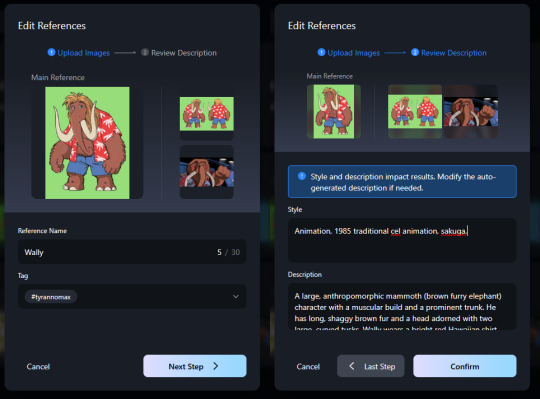
Vidu updated with a major improvement to the reference tool, one that lets you build profiles for each person or location you're using, consisting of up to three images, a short style prompt (about 1 line) and a description-prompt. These are saved to your profile so you can call them up at any time (saving a lot of redundant prompting of character details).
The robot will fill in the description for you, but I suggest editing it to your needs.
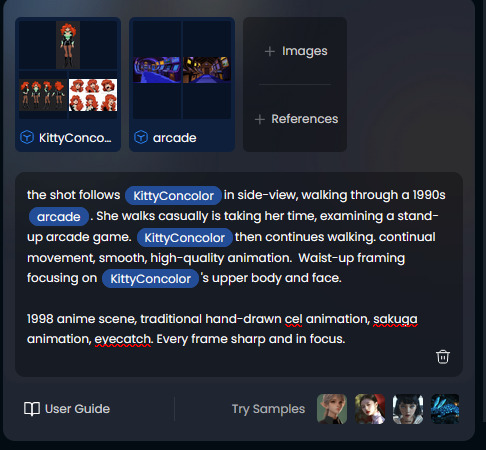
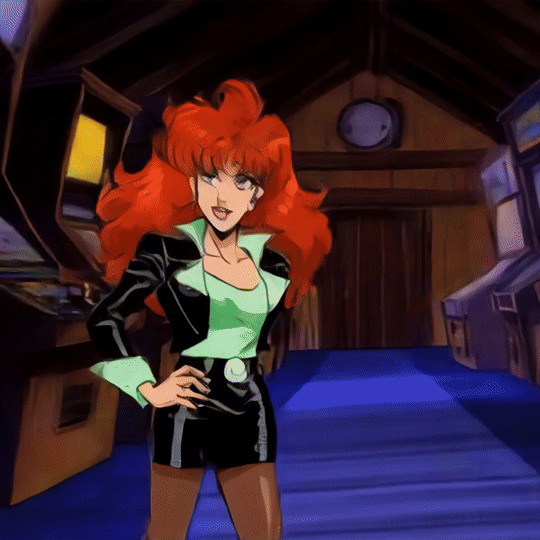
You can use up to three references per shot (scale between references is a little tricky), and, in a very helpful feature, you reference those characters by tag in the prompt body.
In the old reference system you'd tend to have to use a single shot for a character, then a model sheet, because if you did just the model sheet the characters would tend to "twirl" while animating in chaotic and unnatural ways, meaning you'd generally lose two slots to one character, but here you can load everything in one place.
I've only played with it a little bit thus far, but here are my basic recommendations:
The first image should be a single shot of the character, and the second and third images can be model-sheet character assemblages. If you're doing a reference specifically for talking head shots, you'll want the face-shot in the first slot, and full-body reference in the latter ones.
Try and use multiple-angle reference where at all possible. This just increases stability of the character in general, even if they don't show the alternate angles being shown. I have a tutorial for using Vidu to produce this kind of reference here.
Use the extra prompt space for specific visual instruction. The more direction you give, the less chaos and weirdness you get. (Assuming that's your goal.)
#vidu ai#vidu#vidu CCP#ai tutorial#ai video#ai animation#reference prompting#ai assisted art#tyrannomax#kitty concolor
13 notes
·
View notes
Text
My unsolicited thoughts on the production of Newsies that I just saw
I overall enjoyed the show, but it was a mixed bag in some regards so. yeah!
Act 1
Crutchie and Jack were not nearly close enough (physically or emotionally) in the opening scene. Also, Crutchie's crutch was on the wrong side even though the actor playing him apparently has mobility issues?
Some newsies were dropped/sent off by their parents during Carrying the Banner! Amazing! Very neat to see this explicitly acknowledged! 100/10!
Jack was shorter than Katherine <3
Race was implied to be younger than Albert based on their pants styles???
Also, Albert paid for his papes, which was disappointing
This production's Les played the "I'm ten...almost" line very differently from Livesies Les (more a reluctant acknowledgement than aggressive), which I liked (I really liked this production's Les)
The way Pulitzer said "I don't look pretty" absolutely killed me. Also, he was incredibly fidgety during the office scene and Nunzio was visibly irritated by this. The Pulitzer and co scenes were generally really well blocked and acted.
Jack walked into the scene where Snyder shows up with a flower girl that he's implied to be flirting with, which I thought was an interesting addition. She spent most of the scene waiting and looking like she really wanted Jack to pay more attention to her (he was focused on Davey and Les) but did at least stick around long enough to distract Snyder.
"But I can see her - [embarrassed pause] - her legs."
The guy Medda addressed in That's Rich ("hey, baby, I was just talking about you") collapsed in his chair after the acknowledgement even though it's not a particularly positive interaction
During the pre-WWK scene, the ensemble was weirdly quiet the whole time.
Albert had to be held back after the "aw, just let 'em try!" bit
Now that I've seen the UKsies staging/delivery of "I say we save any interviews for a real reporter" I cannot go back to watching Davey deliver the line as directly as he did in this production.
Les tried to volunteer to visit Brooklyn but Davey pulled his hand down, which was hilarious
During the WWK reprise, they did a sort of chair assembly line to get the chairs offstage, which I thought was a good way to incorporate the set change into the choreography.
I wish Jack would've given Katherine more personal space in the post-Jacobi's scene, but it was at least better than Livesies
Also, this Jack overall did not have good pacing in his line delivery
Katherine absolutely crushed WWH and I loved the way she did the "it's a girl" section
I wish Crutchie had been better incorporated into the dances. Maybe it was something to do with the actor's disability, but there has to be a better solution than Crutchie sitting to the side/being offstage half the time during WWK and Seize the Day
After the line about skull-busting Albert stood up to fight the Delanceys and Mush had to pull him back down.
Davey didn't address people individually during the Seize the Day intro :(
Another UKsies related thought is that their choice to have the scabs explicitly be from the main group was a good one and I wish this production had done it too
Jack was really in the thick of it during the fight
As Jack was climbing to the rooftop before Santa Fe, he was audibly sobbing and he kept crying during Santa Fe, which almost made me cry.
A general thought is that the existence of Livesies seems to make directors afraid to do their own thing with the show.
Act 2
Jacobi was running the deli with his...wife? and she was helping patch up some of the newsies pre-KoNY
In this scene, but also in general, Race did not commit to the bit nearly hard enough - "wouldya lookit, that's me! I'm famous!" didn't really feel like a distraction tactic
The ensemble was divided into tap dancers and spoon players (they even had a "spoon captain" listed in the program) and the spoon players at one point played their spoons on the tap dancers' shoes
The Katherine interlude in KoNY was very oddly done and I am not sure what they were trying to accomplish (and she didn't even have tap shoes, which, what?)
The person I knew who was in the show had a dance highlight in the pre-Letter from the Refuge dance break! Yay!
Les was SO funny during the WWHR lead-up and as soon as the date exchange started Jack backed away slowly since he was standing between Davey and Les before.
The Bottom Line (reprise) lead-up was REALLY well-staged
When Katherine was revealed to be Pulitzer's daughter, Katherine was visibly upset at being used as a pawn and Hannah ended up trying to comfort her, with mixed success.
When Pulitzer mentioned Davey, Jack had already been knocked to the floor but he tried to get up and lunge at Pulitzer.
Katherine ran offstage when Pulitzer said "too bad you've no family, but you can't have mine"
The person with the Bronx sign kept the sign turned around until his line
Les was fully not at the rally, which, what?
Jack also didn't get into any physical altercations at the rally, which, again, what? Weird choices were made there!
Much like the pre-WWK scene, the ensemble was weirdly quiet.
This is probably an unoriginal thought about STBI, but I think a potential way to make the "or is it because I'm a girl?" line less weird is to have Katherine deliver it in a more resigned/frustrated than accusatory tone ("I'm dealing with this again? Really?") - her concern of being dismissed is not invalid, but I think it's less to do with Jack specifically and more to do with the world she lives in.
The way Jack said "if you weren't an heiress" killed me
There were fog machines during OAFA and the scene leading up to it, and that plus the lighting during the scene looked SO COOL
Davey and Jack had their arms around each other during the beginning of OAFA and Katherine just kinda stood next to them (close by, but still) which was. a choice.
During the lines "ready to fight us a war" and "talk about seizing the day" there were choreography callbacks to "either they gives us our rights or we gives them a war" and a section of the Seize the Day choreography.
Katherine kissed Jack on the cheek before she left, which was very cute
Davey and Jack stood face-to-face very close together with their hands on each other's shoulders at the end of OAFA and it was, again, certainly a (very gay) choice
Pulitzer terrified Bunsen out of the room during the phone call bit, which led into Bunsen presumably encountering Jack and co. and then escorting them in
Jack turned to Katherine instead of Davey after the Roosevelt handshake, which I disliked not for Javid reasons but just because Davey has context for the interaction and Katherine doesn't.
During the line "New York's got us, and we're family" Pulitzer stuck his head over Katherine's shoulder. Katherine was not particularly happy with this development, but I thought it was funny.
Katherine and Les hugged in the final scene!!!
Snyder being sent to jail in Broadway!Newsies always makes me miss 92sies!Crutchy's "make friends with the rats" line
Jack and Crutchie didn't hug until the very end (right after Jack and Davey hugged), which I thought was a weird choice to make. No one hugged Crutchie when he first entered either, which was sad and honestly made Crutchie feel less like part of the group :( (which is a staging choice I disagree with)
There was no curtain call, just slower-paced bows that extended from the curtain call music through the bow music. Also, someone juggled during the bows?? I need to figure out if I've met that person given how small the juggling community is in my neck of the woods.
...This kind of just turned into a stream of consciousness infodump. Bone apple teeth!
#isabel.tex#newsies#the people i saw the show with i think were not interested in my thoughts. sad!#also i looked up jack's actor and i'm pretty sure he's a trans guy so. trans jack fans rise up i guess?
13 notes
·
View notes
Text
At September’s UN General Assembly in New York, Brazil’s President Lula described the international financial system as a “Marshall Plan in reverse” in which the poorest countries finance the richest. Driving the point home, Lula thundered, “African countries borrow at rates up to eight times higher than Germany and four times higher than the United States.” Lula is not alone in this diagnosis. Centrist technocrats par excellence Larry Summers & NK Singh coauthored a report earlier this year arguing that the development world’s mantra to scale up direct financing to the global South—from “billions to trillions”—has failed. Instead, global finance seems to be running in the opposite direction, from poor to rich countries, as was the case last year. Summers and Singh summarize the arrangement thusly: “millions in, billions out.” Added to this is the great global shift to austerity that makes a mockery of climate and development goals. It’s in this context that talk of “green Marshall Plans”—proposed by Huang Yiping in China and Brian Deese in the US—must be received. Negotiations over technology transfer, market access, and finance deals are a permanent feature of the new cold war: call it strategic green industrial diplomacy. Both the American and Chinese proposals, such as they exist, aim to subsidize the export markets of allied countries to build foreign support for domestic industries. For developing countries, this could mean manufacturing green goods to grab a slice of the trillions of future green economic output and develop themselves, and a policy choice to meet their development goals by either making or buying cheap, clean energy generation, electricity storage, and transport. Putting aside the dubiousness of the historical analogy to the United States’ postwar aid program to Europe, the critical element—and the one that seems least likely for either China or the US to pursue in earnest given their domestic political obstacles—is the provision of the kind of financial and industrial support that low- and middle-income countries need. The geoeconomic contest between the US and China rests on which of the two can forge domestic political coalitions that meet the demand of developing countries for local manufacturing value add in green value chains, without which the South will remain merely an export market or a resource colony.
[...]
The optimistic Marshall Plan proposals are not entirely hot air; each attempts to extend aggressive domestic policies globally. China and the US have both made bids on an investment-led partial solution to their respective domestic political and economic challenges, with a focus on clean-energy industries. Their shared formula can be summarized as national strength through industrial renewal. In both countries, domestic industries have been offered ample fiscal support; Biden’s suite of tax credits and subsidies has already spurred more than $400 billion in investment in clean energy and clean-tech manufacturing and generation, and China’s central government, already dominant in clean tech manufacturing, is now concentrating its efforts on next-generation technologies and economic self-reliance.
11 October 2024
16 notes
·
View notes
Text
Remember that I love you.
Set between chapters 4 and 5 of "Whither is thy beloved gone? "
Astarion tries to cope with Ban's absence in any way he can.
Read on AO3.
He wakes up in a cold sweat, hands fisting into the satin sheets. Alone, yet again. He exhales, running a hand over his face; he registers that it is cold and clammy, even more so than the usual.
A quick moment to slip on his bathrobe and he leaves the room, meandering through large, empty hallways and tomblike rooms that just further remind him how lonely he is.
Can’t live like this, he thinks.
Desperate nighttime thoughts, brought on by endless nightmares that have just seemed to crop up in her absence. Punishment? A cruel joke by the gods?
Who knows? Who cares? All he knows is he’s fucked.
The next day, the Ascendant stands before an old crone.
“Simulacrum,” he says, tapping the scroll she had laid down on the table. “Do you think I can use this?”
The old vendor, who had been summoned here by a frankly confusing flurry of servants in a garishly decorated black and gold carriage, frowns.
“You would require the person to be within touching range, Saer. I apo-”
The smashing of a goblet against a nearby wall makes her flinch. She sneaks a look at her host and sees the man’s chest heaving, his unnervingly crimson eyes wide with something akin to anger-
No, not anger. The man is despondent.
“I see.” Her host’s voice is clipped; the man takes a deep breath, and the next words are somewhat calmer. “Anything else you can offer, then? Any possible solution to this predicament?”
The old crone, unsure, rests her hands on the table, her rather grubby fingers staining the white tablecloth. She sees her host’s lip curl at the sight and quickly withdraws them.
“I may have one or two more ideas,” she offers. “They’re not the best, and it won’t be as good as a simulacrum. But it does fulfill some of�� your needs, if not all.”
“Elaborate.” The man’s eyes bore into her.
She wants to just leave. This mansion feels wrong - too large, too silent, too cold. Why did she even agree to come here in that stupid carriage?
Coin, of course. They offered a lot of it.
She dithers for a moment more. “You can ask a hag-”
“No!”
Well. That’s not going to work then. She considers telling the man to sod off, that she’s done here and taking the coin his lackeys promised her if she’d come with them. But something in the man’s eyes tells her that would be unwise.
Wracking her brain, she comes up with one more solution.
“I do have this… automaton. Won it in a bet one time. It’s old, and can only really say a line or two, but-” She shrugs. “A quick spell of Seeming, perhaps, if you have a portrait of her somewhere. I can sell you the scroll.”
A crude method, one that will probably not produce anything close to the accuracy a simulacrum could achieve. But she can tell this man is desperate.
He considers this, and gives her a sharp nod. “I’ll take both.”
He’s in a spare storeroom, the things he needs to achieve this assembled before him: the automaton, programmed by the crone to say one sentence, the scroll of Seeming, and a painting.
The Hero of Baldur’s Gate.
He has it facedown on the table, refusing to look at it until he absolutely needs to.
The Ascendant casts the spell, reading it off the scroll he holds with trembling fingers.
Astarion opens his eyes to see something that looks like her at a cursory glance. A closer inspection reveals the inconsistencies - the way the face is shaped, the way the lips are positioned, among other, subtler things.
He thinks he can fool himself if he’s a fair distance away, and so he drags his chair a few meters back and sits, a goblet of wine still in his other hand. His eyes never leave the auto-
Ban. His eyes never leave Ban.
He should have drank more before this, he realizes, but it’s too late. He’s too sober, too lonely, and that thing looks enough like her that he feels something stir in his breast.
“Come back.” He tries it out, and finds it easy to speak the words he can’t say to the real Ban.
“I need you.” Not-Ban stares at him in silence.
“I love you.”
Ban seems to glare at him at these words, as if accusing him of lying.
“I’m not- I never meant to-“
Fuck. Fuck.
It’s not her, just a damned illusion, and yet he feels his heart crack. He sees the deep, bottomless chasm of his loneliness; a pain that seems to have no end and no way for him to ease.
He raises the now-empty goblet, aiming a hard, spiteful throw at the automation. The goblet, much like the others he’s thrown, shatters.
The hit activates it, and it speaks.
“Remember that I love you.”
It’s not even her voice; but it’s Not-Ban’s mouth that moves.
It’s enough, close enough to make his eyes sting and his breath catch.
It doesn’t matter that this isn’t her. That she won’t ever want to see him again, or hear what he wishes he could say.
He says it anyway, says it to the illusion in front of him, says everything he never got to.
He tells her he’s hurt, that he’s scared, and that all he wants is to be loved and why is that so fucking hard?
The sun rises; eight hours have passed. The spell breaks.
The Ascendant leaves the room, leaving a mess of shattered glass and scattered machine parts.
Taglist: @elora-the-slutty-songstress @tragedybunny @spacebarbarianweird @ayselluna @enterthedreams @coltaire @qiific3 @misscrissfemmefatale @vixstarria @eatyourheartoutmylove @linllewellyn @ battisonsgf @micropoe10 @thegoodwitchs-blog @akirahime @velcyrptrr @i-cant-get-into-my-other-account @babblebrain-blog @asterordinary @last-but-not-the-least @artist4theworld @gracemisconduct @decadentcoffeewizard @rootin-tootin-n-kind@pursuitseternal@youngtacobanana @krispeenuggiez @pursuitseternal@girlygmer-blog @cheezits4lyfe @vinegarjello @the0ldmann
#astarion#astarion baldurs gate#baldurs gate astarion#astarion x tav#astarion fic#bg3#bg3 astarion#astarion ancunin#astarion bg3#ascended astarion x tav#astarion ascended#vampire ascendant#ascendant astarion#ascended astarion#astarion fanfiction#astarion fanfic#astarion angst#bg3 fic#bg3 fanfiction#bg3 fanfic#bg3 angst
38 notes
·
View notes
Text
Last month, Philippe Lazzarini, the head of the United Nations Relief and Works Agency for Palestine Refugees (UNRWA), said that the agency had reached a “breaking point.” After Israel accused 12 agency personnel of involvement in the Oct. 7, 2023, Hamas attacks, 18 states announced in January that they would suspend funding to UNRWA, including its two top donors: the United States and Germany. On Saturday, the U.S. Congress barred funding to the agency through March 2025.
Although Lazzarini has dismissed 10 of the employees (the other two are dead), and the U.N. promptly launched an investigation into the allegation, most donor states have refused to resume funding until the investigation is finished. The European Commission, Sweden, and Canada have released some of their pledged funds, but the agency continues to exist “hand-to-mouth” amid the very real risk of being forced to shut its doors.
Now that Israeli Prime Minister Benjamin Netanyahu has outlined his postwar plans for the Gaza Strip, which include closing UNRWA, the agency’s future looks even more unstable. Yet to shutter UNRWA would be a betrayal of Palestinians. The agency, which provides essential services to 5.9 million Palestinian refugees, has been a stopgap for almost 75 years as the international community has failed to find a durable solution for Palestinians.
UNRWA—which I worked for between 2019 and 2022—cannot solve the root causes of Palestinians’ dispossession, but for decades, it has managed to address the symptoms. It has also become Palestinians’ only effective representative on the international stage. In the absence of a political solution, the international community owes it to Palestinians to ensure that UNRWA remains operational amid one of the worst humanitarian crises in its history.
UNRWA originated as a makeshift solution to a thorny problem. After the creation of the state of Israel in 1948 displaced around 750,000 Palestinians, the U.N. General Assembly (UNGA) passed two crucial resolutions. The first, Resolution 194, enshrined Palestinian refugees’ right to return to their homes and established the U.N. Conciliation Commission for Palestine to promote a durable solution for Palestinians. The following year, Resolution 302 set up UNRWA as a subsidiary organ of UNGA to conduct “direct relief and works programmes” that would incentivize Palestinians to settle in neighboring countries.
The fact that UNGA endorsed two such differing approaches just a year apart reflects the deadlock that diplomats faced. Months after the Conciliation Commission for Palestine was founded, it came to a dead end; the only solution acceptable to Palestinians was return—a solution that Israel would not consider. Diplomats had to come up with an alternative.
In September 1949, the U.N. sent an Economic Survey Mission to countries to which Palestinians were displaced. The mission concluded that “relief and public works” programs would “increase the practical alternatives available to refugees, and thereby encourage a more realistic view of the kind of future they want and the kind they can achieve.” The implication was clear: Palestinians should be encouraged to stay in their host countries, such as Jordan, Syria, and Lebanon.
UNRWA was thus established in 1949 with a yearlong temporary mandate to serve “persons whose normal place of residence was Palestine during the period 1 June 1946 to 15 May 1948, and who lost both home and means of livelihood as a result of the 1948 conflict.” Aid workers quickly began providing rations to 950,000 refugees, and the agency offered a modest income to the Palestinians who assisted in the delivery of relief.
Yet diplomats’ dreams of turning beneficiaries into well-integrated, self-sufficient employees soon faded. Palestinians, relegated to overcrowded camps, faced high levels of poverty, malnutrition, and disease. In any case, refugees would not give up on returning home. Nor would Arab states encourage integration within their borders. From their perspective, doing so would allow Israel to evade its responsibility to Palestinian refugees.
They also feared upsetting delicate sectarian balances. In the case of Lebanon, the 100,000 predominantly Sunni Palestinians it hosted constituted around 10 percent of the country’s population, leaving its sectarian power-sharing system based on a 1932 census dangerously out of date.
With the political avenue dead and no Palestinian state established, UNRWA soon took on a role that diplomats had not foreseen. The agency grew to become a quasi-state, delivering services that a government would normally provide. Today, UNRWA is the backbone not just of Gaza and the West Bank, but also of Palestinian refugee camps in Jordan, Lebanon, and Syria, providing education, maternal care, social work, university scholarships, camp infrastructure, and vocational training. It employs 30,000 Palestinian refugees, providing a lifeline amid economic deprivation.
Despite its outsized role, UNRWA remains strictly a relief agency, unable to fix a problem far beyond its mandate. The U.N. High Commissioner for Refugees, an agency mandated to aid every refugee population except for Palestinians, advocates for durable solutions for refugees. It defines these as integration in the host country, resettlement in a third country, or return home. But UNRWA has no power to advocate for a durable solution for Palestine refugees.
In the words of Ardi Imseis, who worked in the UNRWA’s legal division before becoming a legal scholar, UNRWA has taken “a development approach to what is a legal issue.” It provides relief and employment to people whose dispossession and exile cannot be resolved through humanitarian assistance. UNRWA’s narrow mandate means that it can never work itself out of a job: A political solution must be found first—until then, UNRWA duct-tapes over the cracks.
Although its weak mandate simply perpetuates the status quo, the agency faces regular political attacks. Those who wish to prevent Palestinians from returning often criticize UNRWA, whose existence serves as evidence of Palestinians’ protracted exile.
“Israel would like there to be an existential threat to UNRWA because they mistakenly think if you get rid of UNRWA then you suddenly get rid of the [nearly 6 million] refugees and their right to return,” former UNRWA spokesperson Chris Gunness recently told Reuters. In December 2022, when UNGA renewed UNRWA’s mandate until June 2026, 157 member states voted in favor; Israel objected; the United States, Canada, and eight other countries abstained.
UNRWA’s detractors have only ramped up the pressure in recent years. Pro-Israel pressure groups such as IMPACT-se and U.N. Watch (which has no affiliation to the U.N.) frequently release so-called research reports that resort to tactics such as filming students outside of UNRWA schools and using the children’s statements about their villages of origin in historical Palestine as evidence of alleged propaganda in the agency’s educational system. Monitoring the Facebook pages of UNRWA employees—many of whom work sporadically on day-laborer contracts and live in active conflict zones such as Gaza or Syria—also provides ample fodder for detractors.
Palestinians have also demanded more of UNRWA—namely, to push for the right to return. Yet they have no way of influencing the agency’s priorities, and in any case, UNRWA is unable to meet these demands. Because it is not a state, it cannot advocate for a political solution for Palestinians on the international stage or collect taxes and fund their strategic priorities. Its temporary relief and works mandate can only be altered by UNGA. That Palestinians haven’t lost all faith in UNRWA shows how poor their political prospects are.
UNRWA’s response to the pressures it faces on both sides is to reaffirm its neutrality. It is the only U.N. agency that has a “neutrality team,” which monitors staff conduct, vets all personnel and beneficiaries, inspects the use of its buildings, and seeks to ensure that the curricula taught in UNRWA schools cannot be perceived as biased.
My experience at UNRWA was that in practice, resources focused on neutrality can verge on the absurd given the agency’s dire financial straits. When I worked on neutrality, I was frequently challenged by my Palestinian colleagues about the millions of dollars spent on related processes—for example, quarterly inspections of schools and health clinics for graffiti that could betray any preference for a party to the conflict—while services for refugees were cut. (I reached out to UNRWA for comment but received no response.)
After a pressure group accused UNRWA of promoting jihadism in its schools, I was tasked with scanning thousands of lesson plans for words with the Arabic root j-h-d. I produced reams of talking points to explain to donors the distinction between the word mujtahid (“hard-working”) and jihad (“struggle,” but often taken to mean “holy war”). As I worked on these sorts of projects, often late into the night, it often occurred to me that the money and time poured into neutrality would better be spent on rations in Gaza and Syria.
The agency-wide obsession with neutrality is, however, understandable: Every accusation of bias can harm UNRWA’s ability to provide basic services. UNRWA frequently faces suspensions of funding after poorly evidenced attacks on the agency, followed by periods of costly reform. After then-U.S. President Donald Trump withdrew funding from the agency in 2018, citing the need for reform, it was plunged into financial crisis and experienced months in which it failed to pay staff salaries.
Palestinians thus live in constant fear of budget cuts to discretionary, voluntary assistance from donors. Indeed, UNRWA has been mired in financial crisis since its inception: Its first report to UNGA in 1952 concluded that “[r]elief cannot be indefinitely provided. This is an inescapable and significant fact, for the time is rapidly approaching when voluntary contributions for the provision of relief for the Palestine refugees will no longer be forthcoming.”
The news of UNRWA employees’ potential involvement in the Oct. 7 attacks is extremely serious. Yet given the severity of destruction in Gaza, donors’ hasty decision to suspend funds cannot be divorced from the broader politicization of UNRWA.
The irony of this is that UNRWA’s woes are of the international community’s own making. In the absence of any conciliation process—nothing has filled the gap of the ill-fated U.N. Conciliation Commission for Palestine since the 1950s—UNRWA has proven an easy target for critics from all parties to the conflict.
However, without a peace process, there is also no exit strategy from UNRWA. The international community has promoted the agency as the service provider of all relief and employer of thousands of Palestinian refugees. No humanitarian actor can fill the gap; UNRWA provides logistics, storage, and transport to other nongovernmental organizations and U.N. agencies. Moreover, if UNRWA were to close, its 30,000 personnel and their family members would soon be added to the list of aid agencies’ beneficiaries.
After refusing for decades to take Palestinian statehood seriously—15 of the states to withdraw funding have not recognized the state of Palestine—the decision now to cut UNRWA’s funding is an illogical stance as good as a death sentence. It is the international community’s duty to follow through with its humanitarian assistance until a solution to the Israeli-Palestinian conflict is achieved.
20 notes
·
View notes
Text
In December, I had the honor of attending and addressing the Limmud Conference in Birmingham, England. Over 1,700 Jews of all types and levels of observance, assembled as they do each year, in a conference center in order to study Judaism. Every hour slot has ten to fifteen different speaker options and you can join the discussion on anything from Jewish law, history and philosophy to Jewish art, literature, food, and comedy. Beyond my own five sessions, I had the opportunity to listen to many other fascinating speakers, but one session I enjoyed tremendously was that of an organization that calls itself “Rabbis for Human Rights.”
The session was attended by some fifty people and appealed to the more “Anti-Zionist” Jews at the conference. In previous years it would have attracted hundreds of attendees, but in the aftermath of October 7 thankfully the number of Jews prepared to “bash” Israel has been severely depleted.
The Rabbi for Human Rights presented his case: Israel was being torn apart by violent settlers in the “Occupied” West Bank. With an “extreme” right-wing government, where all the power is in the hands of Smotrich and Ben Gvir, the State of Israel will not last long. The solution? An immediate ceasefire and a two-state solution with our Palestinian neighbors.
After his twenty-minute monologue, I raised my hand and stood to address him and the room. I began:
“Firstly, may I congratulate you on your masterful analysis of the situation in Israel today. May I also suggest that you and I have a lot in common:
“You are a rabbi and I am a rabbi.
“You believe in human rights and I believe in human rights.
“You are a settler in the Occupied West Bank, and I am a settler in the Occupied West Bank.”
That last comparison made him uncomfortable. Didn’t I know that he lives in Tel Aviv – in “Israel proper?”
“Let me explain. Our enemies have made it very clear to the world since October 7 that they believe Palestine should extend ‘From the river to the sea.’ In fact, they attacked the Gaza Envelope, not Judea and Samaria. In other words, they consider every Jew who lives west of the Jordan River to be a settler, and all of our land is ‘occupied.’ So, we are both, at least in the minds of our enemies, settlers in the Occupied West Bank.”
I continued. “But there is one difference between you and me. You are a pessimist and I am a realist. You see the cup as half empty, and I have tremendous hope for the future. Our brave soldiers have performed miracles over the past year and a half, obliterating Hezbollah and Syria and crippling Hamas. In a few weeks’ time, Please G-d, we will see an Israeli attack on the Iranian nuclear program and hopefully the downfall of that regime. We have never been closer to shalom in the Middle East and the liberation of two hundred million Arabs, who currently live under tyrannical regimes that spend all their resources on weapons rather than healthcare and education. I have never been more hopeful for an improvement in human rights for our Arab neighbors who currently score amongst the lowest in the world on that index. I have never been more hopeful for shalom – long-lasting peace – with our neighbors.” With that I sat down.
Unexpectedly, around one third of the people in the room burst into spontaneous applause. Perhaps another third would have liked to but were too embarrassed to show their approval. I was happy to see that, at least in some debating chambers in the UK, people are still willing to listen to the other side.
So why do our enemies hate us? Why does Iran spend most of its budget building weapons to exterminate us, when we live over 2,000 kilometers from their border? Why do the most evil nations also have the worst human rights records in the treatment of their own people.
In this week’s parsha, Shemot, we are first introduced to the new Pharaoh. Very soon he is telling the Egyptian people (Shemot 1:9-10), “Look! The Israelite people are becoming more numerous and stronger than us. Let us deal cleverly with them lest they increase and, in the event of war, join our enemies.”
The new Pharaoh is not a caring leader. The previous Pharaoh, the one that appointed Joseph as his prime minister, was quite willing to impoverish his whole nation and nationalize all their land, and the Torah portrays him as a tzaddik compared to his successor. Some of the Egyptian people must still have remembered the “good old days” when Mum and Dad owned the farm and life was easier. There must have been some level of national unrest with this new dictator.
So, if this new Pharaoh has an image problem with his own people, why would he not focus on building schools and hospitals in Rameses, rather than extravagant pyramids for his family? Why would he not invest in infrastructure like canals to enable better irrigation? Or papyrus factories to get more school books published?
The Torah answers this for us. He is ultimately interested in filling his own pockets and doesn’t give a hoot about his people. However, in order to keep them oppressed and prevent an uprising, he creates a scapegoat. If he can scare the people about the dangers from those “crafty Jews,” he can distract them from their own suffering. Not only can he justify enslaving the people whose leader, Joseph, just collected the Nobel Prize for food security, but he can also keep his Egyptian nationals under control.
This has been a template for Arab dictators since the Exodus story: blame the Jews and keep your own people in abject poverty.
Having read this story every year for 3,500 years, the Jewish people have just woken up to the fact that we don’t need to stay in this loop forever. The current war has shown Israel to be far stronger than anyone imagined, including, and especially, ourselves. We no longer have to put up with Arab dictators spending their whole budget (and that of the UN and their Arab oil sponsors) on weapons of mass destruction against us.
As a rabbi for Human Rights, my wish is for the Pharaohs of the New Middle East to focus their funds on helping their own people climb out of poverty through education and technology. May we soon see them melting their missiles into ploughshares and their rocket launchers into desalination plants. May one Arab nation no longer lift swords against any non-Arab nation. Instead of learning war, may they learn respect for women’s rights and education, freedom of the press and tolerance of other religions. And may this happen before they totally destroy themselves. Amen.
4 notes
·
View notes
Text
Ch. 2 edited to include the cool station descriptions, ch. 3 edited in small ways for style and clarity! And in the meantime, please have some three-way diplomacy and conversations about past and present...
Chapter 4: Regrets
I mean, that's a valid concern, Aspen said when they were pulled into the discussion a few hours later. That did happen.
By that point, Dandelion had already docked, while ART was hanging somewhat off-station so as not to interfere with the traffic. But the discussion still grew like tangled invasive planetary flora and now not only Seth, Iris and Karime were involved, but also Mensah, Thiago and Pin-Lee from the Preservation side, because I wasn't happy about Aspen potentially losing my humans either, and Captain Reed and Joscelyn from Dandelion's side, because she thought her humans should also know about what was going on.
Dandelion gave them a skeptical look.
It was more complicated than you're making it out to be, Aspen.
They gave a shaky laugh. I can't believe you're saying that, of all people.
I am, because Perihelion's concerns here aren't our concerns, and you should be addressing them rather than your own guilt. Dandelion said bluntly, and about a third of Aspen's running processes flickered, like they were wincing in pain. You weren't in direct control of the Courageous' functions back then.
They still died on my watch, they said stubbornly, reconsolidating themselves, and when Dandelion didn't refute that, they turned to ART and the assembled humans. All right. I can tell you the entire story, but before I do that, I want to say something. Perihelion, I worked on your psychoprofile a lot when you were going through that training program, and, well, there's a reason we decided not to use any of the data from those incidents for it. Or any media based on the Courageous' initial journey. Putting it mildly, it's the stuff of your own personal nightmares, and I'm pretty sure you would regret hearing the details. Besides, Dandelion is right about one thing: a repetition of that situation is technically impossible, because your crew aren't in chronostasis pods and aren't feed linked into me in any way that could kill them. And while we've had other security incidents and accidents since then, of course, none of them were on that scale. I can give you a log of recent ones, that wouldn't be a problem.
I suddenly had a horrible suspicion, so I poked Dandelion and she opened a private channel.
It was the brain-eating AI incident, wasn't it.
Yes.
Oh fuck no, my humans were not going aboard that thing!
Why the fuck didn't you tell us that the Courageous is the brain-eating AI?!
Because it isn't. The Courageous is the husk of the brain-eating AI, whose functions were eventually taken over by a colonist who was awake during the initial journey and who killed the brain-eating AI. Or half of it, at least. Which also involved killing the colonists whose brains were taken over, as well as those unlucky enough to simply be sleeping in the compromised chronostasis rings.
Dandelion. What the fuck.
She shrugged.
That was the single most common question on our javelin back in the day. The long and short of it, SecUnit, is that Aspen is not the killer AI, and we've taken every step we could think of so that none of us could be a killer AI like that again. However, they are responsible for killing those people. Make of that what you will.
Okay. I needed some time to process that.
Mensah said, I see your point, Dr. Courageous, but perhaps I can offer an alternate solution. If your concern is for Perihelion's psychological health, perhaps you could give the information to others in its crew, and they could make the evaluation instead. If that's all right with you, of course, Perihelion.
Maybe. ART said. It was seriously considering that it really did not want to watch the kind of horrible media that even Dandelion hadn't dared to give it.
Not concerned for your own delegation, Dr. Mensah? Aspen asked in a suspiciously light tone.
Mensah gave them a polite smile.
Dr. Courageous, I don't know if you've had the chance to read the materials we've sent ahead of our coming?
I have! Please give my regards to Dr. Paudel for compiling them. I appreciated the context.
Of course. But then you know very well that Preservation itself was founded after a colonization attempt turned disastrous by corporate greed. Our forebears survived by sheer luck and a modicum of skill, but just as many did not. Outside of the feed meeting, she raised her head proudly and looked at Courageous Station through the observation lounge window, smiling. We would be hypocrites of the highest order to shy away from people who had to suffer the same and are thriving regardless. We're going.
Thiago and Pin-Lee sent approving pings into the feed. They didn't even need to discuss it on our Preservation-only channel. Thiago's judgments were generally fucked up, so that wasn't much of an indication, but Pin-Lee and Mensah agreeing on this made my threat assessment go down from red to yellow, which I sent to ART.
Okay, Iris said on ART's internal crew channel. We know the Javelin program had all sorts of problems, Peri, but if their colony not only survived, but grew to several worlds, they must have fixed the one that nearly killed them on the way. It's not like we can blame them for something that happened over two hundred years ago!
Then why did the Courageous say they were responsible? ART said pointedly.
Good question, Seth said. But Dr. Mensah's suggestion seems sound enough to me. Perihelion, would you be amenable to this?
ART sent me a query requesting my analysis, and I confirmed. ART said suspiciously: So you're letting your humans go. What do you know about it?
I've pieced some of it together from Dandelion's remarks on your jump training, and yeah, you really don't want to hear the details. But the Courageous is right: it was a chronostasis-related disaster, so it's not actively dangerous to our humans. I'm not going to object to them going.
I think we're going to regret this, ART said to me. And then it switched to the general crew channel and said: Very well. I'll trust your judgments.
4 notes
·
View notes
Text

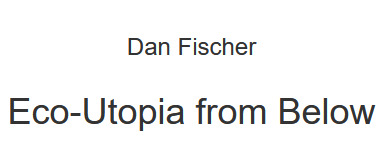
The Solutions Are Already Here: Ecological Revolt from Below By: Peter Gelderloos London: Pluto Press, 2022
Half-Earth Socialism: A Plan to Save the Future from Extinction, Climate Change and Pandemics By: Troy Vettese and Drew Pendergrass London: Verso Books, 2022
At a time when much climate literature emphasizes inadequate “deals” with capitalism or catastrophe-prone nuclear and geoengineering technologies, it’s refreshing to read two uncompromising proposals for ecological revolution. Despite coming from different political traditions, anarchist and Marxist, they reach overlapping conclusions regarding the necessity to reject elites’ false solutions, reduce global production, support participatory planning, and establish healthier relations with nonhuman beings. With solutions at hand, and the dead-ends increasingly obvious, the ways forward appear to be getting clearer.
Solutions Abound
First, Peter Gelderloos’s The Solutions Are Already Here: Ecological Revolt from Below, is a cartography of movements resisting extraction, growing local food, and restoring ecosystems. Compared to the ecocidal ruling class and its spurious opposition among the mainstream left, autonomous uprisings can be remarkably effective using a minimum of resources. Based on extensive research and interviews, Gelderloos demonstrates that this web of struggle “represents the best hope for our planet” (146), should it further scale up and coordinate efforts.
He discusses, for example, Mexico’s town of Cherán where P’uerépecha residents militantly rose up in 2011 and kicked out loggers, drug cartels, police, and politicians. Ever since, they have self-governed using horizontal methods of popular assembly and communal mediation (127). Volunteer patrols, accountable to popular councils, confiscate chainsaws from unauthorized loggers and monitor that farmers follow the ban on growing water-intensive avocado trees for commercial purposes. The town has implemented one of Mexico’s most advanced recycling programs, and with help from an impressive tree nursery, they’ve reforested over half of the previously deforested area.[1]
Gelderloos discusses how various communities grow their own food. We read of Brazil’s Teia dos Povos network which has reclaimed large territories and grown enough food to live on. Its farmers are generally either practicing or transitioning to agroecology (110). Also in Brazil, Tupi-Guaraní communities, with support from anarchists in Cultive Resistência, are recovering and restoring land that’s been damaged by mining. They meet daily needs with their own harvests, including sweet potatoes, cassava, and fruit (116). The Solutions Are Already Here describes sizable urban farming and gardening projects established by horizontally run communes, including the Canary Islands’ La Esperanza, South Africa’s Abahlali baseMjondolo, and Mississippi’s Cooperation Jackson (134, 141, 144).
Like the radical ecological movement itself, the book’s strongest suit regards blockades of extractive projects. Gelderloos interviews an anarchist involved in the Dayak tribes’ struggles against oil palm plantations. Blocking roads and seizing heavy equipment, the Dayak have halted land clearing, at least for now, in the Lamandau Regency, on the island of Kalimantan (Borneo), Indonesia (91). When covering more well-known blockades, such as France’s ZAD, Gelderloos criticizes how reformist elements defanged the movement shortly after it successfully stopped a planned airport (93–102).
Had it been a longer book, Solutions likely would have discussed other contemporary eco-societies, such as Sri Lanka’s Sarvodaya Shramadana Movement, Mexico’s Zapatistas, Syria’s Democratic Confederalists, and Brazil’s Landless Workers Movement, in addition to countless other localities maintaining Indigenous and traditional practices of sustainability. It also might have argued for the importance of global cooperation through bottom-up federations like La Via Campesina, Global Ecovillage Network, and the International Workers’ Association.[2]
Gelderloos does not dwell much on the technological aspects of solutions, but the relatively low-tech future he envisions could easily be powered with small-scale renewables. He imagines decentralized production of wind turbines and tin-based perovskite solar cells, land transportation by electric-powered trains and buses, and ocean transportation by expropriated sailboats and yachts. His apparent support for bioenergy is less convincing (177, 188). Not only does all bioenergy emit toxins and carbon dioxide, but Gelderloos’s proposed burning of agricultural residue is even dirtier than burning trees.[3] He also seems to support spreading biochar in fields, an understudied practice that risks emitting airborne particulate matter and negatively impacting plant growth.[4]
Gelderloos calls, in short, for “the networking of thousands of empowered territories” that can survive, outlast, and replace the dying capitalist system (199). However ambitious this sounds, it beats waiting for improbable salvation from CEOs and presidents.
#climate crisis#book review#Climate Justice#total liberation#anarchism#anarchy#anarchist society#practical anarchy#practical anarchism#resistance#autonomy#revolution#communism#anti capitalist#anti capitalism#late stage capitalism#daily posts#libraries#leftism#social issues#anarchy works#anarchist library#survival#freedom#Dan Fischer
4 notes
·
View notes
Text
WhatMatters
Your guide to California policy and politics

By Lynn La
May 27, 2025
Presented by The Nature Conservancy, TURN – The Utility Reform Network, CA Primary Care Association and San Jose Spotlight

Good morning, California.
CA lawmakers halt hundreds of bills with new spending as deficits loom

Assemblymembers meet during a suspense file hearing at the Capitol Annex Swing Space in Sacramento on May 23, 2025. Photo by Fred Greaves for CalMatters
State legislators on Friday halted hundreds of bills with new spending attached from advancing. Why? The Legislature again underwent its relatively opaque process known as the “suspense file.” Hanging over lawmakers’ heads is the expected $12 billion state budget deficit that is projected to worsen due to federal tariffs and increased state health care spending.
The Assembly and Senate’s appropriations committees hold these proceedings twice a year. As CalMatters’ Jeanne Kuang and Yue Stella Yu explain, 32% of 1,098 measures were held in the committees on Friday — meaning those proposals are essentially dead or shelved for the year.
Assemblymember Buffy Wicks, an Oakland Democrat and chairperson of the Assembly appropriations committee: “Many good bills are going to fall by the wayside today. We are not in a year where we can be expanding programs, developing new offices, new agencies, new departments and expanding our footprints.”
The Assembly trimmed about the same number of bills compared to last May, while the Senate squashed a slightly higher percentage of bills (29% compared to 25.5% in 2024), according to longtime lobbyist Chris Micheli.
Some notable bills that didn’t advance included ones that would have expanded health care services, such as a proposal to seek federal approval to cover some housing services under Medi-Cal, an insurance program for low-income residents, and another to allow more Medi-Cal patients to receive home-based care.
Two crime bills, both introduced by Republicans, were also spiked. One would have barred some prisoners from being released early through the state’s elderly parole program, and the other would have increased penalties for giving fentanyl to minors.
But the committees did pass 742 other bills, including a proposal by Assemblymember Rick Zbur and backed by Gov. Gavin Newsom to expand tax credits for the state’s film industry. Though language to increase the state’s film tax credit to $750 million annually was struck from the bill, the specific amount is expected to be ironed out during budget negotiations, said Zbur, a Los Angeles Democrat.
The bills that survived on Friday will face another hurdle next week, when they must advance out of the chamber — Assembly or Senate — where they were introduced.
Read more here.
CalMatters covers the Capitol: We have guides and stories to keep track of bills and your lawmakers; find out how well legislators are representing you; explore the Legislature’s record diversity; and make your voice heard.
Other Stories You Should Know
Big state deficits through 2029

Gov. Newsom unveiling his revised 2025-26 budget proposal at the Capitol Annex Swing Space in Sacramento on May 14, 2025. Photo by Fred Greaves for CalMatters
The nonpartisan Legislative Analyst’s Office agrees with the Newsom administration that the state is “likely to face persistent future deficits” which are expected to range from $10 billion to $20 billion through the next four years. The latest number-crunching by the analyst’s office dropped Saturday, a typical occurrence that follows the governor’s unveiling earlier this month of his updated state budget plan, which also projected years of operating deficits in the tens of billions.
One of Newsom’s key proposals to help reduce spending and plug the budget hole is to limit new Medi-Cal recipients, particularly freezing enrollment for adult immigrants who do not have permanent legal status. The office recommends that the Legislature should “maintain at least the level of ongoing solutions” as proposed by the governor, but could adopt “additional solutions” in anticipation of future deficits.
Some bit of good news: Because of slightly higher revenue estimates, the analyst’s office projects that this year’s budget condition will improve by nearly $2 billion compared to the administration’s assessment. But uncertain “federal budget changes” are likely to add more financial pressures on the state, according to the office. All this info will shape the discussions between lawmakers and Newsom as they craft a budget deal for the next year by late June.
How federal budget bill could impact Medi-Cal

The U.S. Capitol Building viewed from the National Mall in Washington, D.C. on April 4, 2025. Photo by Samuel Corum, AP
Speaking of “federal budget changes” the Republican-led U.S. House of Representatives last week advanced a budget package that could have major effects on millions of low-income Californians enrolled in Medicaid.
Nationally, the bill guts Medicaid spending by $700 billion, which could lead to California losing as much as $20 billion a year and 217,000 jobs, according to an April analysis by the UC Berkeley Labor Center.
To reduce costs, the bill proposes cutting funding for states that provide coverage to immigrants without legal status, which would affect California. It would also limit the number of new enrollees by imposing proof of work hours.
About 15 million Californians are on Medi-Cal, the state’s implementation of Medicaid. But roughly 29% of Medi-Cal recipients are unable to work due to caregiving responsibilities, school, having a disability or other reasons. The new work requirements could jeopardize coverage for as many as 3.5 million Californians according to a Center on Budget and Policy Priorities analysis.
The House advanced the bill with all 43 California Democrats voting against it and all nine GOP members — who represent a total of 2.5 million Medi-Cal enrollees — voting for it. At least one right-leaning group in California says the cuts are warranted to curb federal spending.
The U.S. Senate has to approve the bill, but some GOP senators say the bill doesn’t cut enough to address the national debt.
And lastly: A fire-resistant neighborhood in CA

A model home in the Dixon Trail neighborhood of Escondido on April 24, 2025. Photo by Adriana Heldiz, CalMatters
A neighborhood in San Diego County is the first purpose-built “wildfire resilient neighborhood” in the country. CalMatters’ Ben Christopher and video strategy director Robert Meeks have a video segment on Dixon Trail and the challenges of statewide home hardening as part of our partnership with PBS SoCal. Watch it here.
SoCalMatters airs at 5:58 p.m. weekdays on PBS SoCal.
California Voices
Though the state has made strides to distribute more drinking water, it needs to do more to ensure a reliable drinking water infrastructure, writes Mary Benson, a former operator of a small water system at Clear Lake.
Other things worth your time:
Some stories may require a subscription to read.
CA Republicans would love former VP Harris to run for governor // Politico
Villaraigosa, despite climate credentials, pivots toward oil industry in run for governor // Los Angeles Times
Rep. Liccardo pushes back against Trump cuts after $50M loss threatens efforts to rein in coastal erosion // The Mercury News
US attorney in LA moves to ‘neutralize’ CA’s sanctuary rules // Los Angeles Times
Immigration is the only thing propping up CA’s population // The Wall Street Journal
This Bay Area county says it cut ties with ICE. This program says otherwise // Bolts
CA turns on water to create new wetlands on the shore of the shrinking Salton Sea // Los Angeles Times
Deportation effort escalates, agents make arrests outside San Diego immigration courtrooms // The San Diego Union-Tribune
In CA, there’s one import that nobody wants // The New York Times
See you next time!
Tips, insight or feedback? Email [email protected]. Subscribe to CalMatters newsletters here. Follow CalMatters on Facebook and Twitter.
About Us· How We're Funded· Subscribe· Donate
CalMatters 1017 L Street #261 Sacramento, CA 95814 United States
2 notes
·
View notes
Text
Excerpt from this New York Times story:
This week, top officials from dozens of African countries convened with major international lenders to commit to the biggest rollout of renewable energy in the continent’s history.
The $35 billion in loans from The World Bank, African Development Bank and other financial institutions, at below-market interest rates, are aimed at getting electricity to half of the 600 million Africans without it. About half the money will go toward village-level solar grids.
It wasn’t just a hopeful moment for people who’ve been deprived of the most foundational facet of modern life. It’s a moment that could have enormous climate implications.
And yet, the words “climate change” were barely uttered at the two-day summit in Dar es Salaam, Tanzania.
One moment encapsulated the dynamic. Akinwumi Adesina, head of the African Development Bank, was onstage on Monday speaking to the assembled leaders. He pointed into the crowd, picking out Mukhtar Babayev, the Azerbaijani official who was president of last year’s United Nations climate summit, known as COP.
Africa is yearning to grow. Over the next decade, hundreds of millions of Africans will need jobs that don’t currently exist. In many countries, societal collapse is not just a worry, it is an ongoing disaster that scores of people will do anything to escape from. Expanding electricity access is one of the surest ways to start strengthening Africa’s long hobbled and exploited economies.
So, back to why climate change barely got a shout-out at a conference with such obvious climate implications.
With the blame for climate change lying undeniably at the feet of Africa’s former colonizers, and with the United States, which has just elected a leader who has called climate change a hoax, Africa’s leaders are done crowing about the issue. They know the developed world is not acting fast enough to enact durable solutions to the climate crisis.
Instead, they want investment and development. They want it affordably, and they want it as soon as possible. They want to avoid further instability as population growth remains high.
China saw that coming, not just in Africa but around the developing world. The solar-energy industry China built over the past decade — a sector China now completely dominates — has enabled lenders like the World Bank to confidently say at summits like this week’s in Tanzania that solar is what will bring Africans energy quickest and at least cost.
4 notes
·
View notes
Text
Jidan Electronic Co., Ltd.
Type: Bootleg Tamagotchi company, bootleg digital game company Founded: 2004 [source] Logo:

About: Jidan is well known for its truly strange infrared tamagotchi clones, such as Honey Lover (which is apparently two tamagotchis that graphically mate using infrared). They claim to be compatible with actual Tamagotchis.
Jidan also makes low-quality Gameboy Advance clones.
Notably, much of the packaging is in Spanish. Official Company Description:
Jidan Electronic Toys built in 2004, and the main products include all kind of handheld game like brick, virtual pet, infrared pet, and icon game etc. Except these popular game, we have a professional development team to develop and design new toy&game accroding to client requirements.
In 2005, we set up own wholesale store in GuangZhou to show our items and serve clients directly and conveniently.
As company setup, we have developed the closest relationship with several factories who in charge of the whole assembly process. They are the foundtion of production. Another partner is the software design team responsible for the application and R&D of electronic system. With their cooperation, we can create and produce all the items required.
We are a group conbiming the strength of market analysis, product design, programming, and manufacture. And we will offer the most various and competitive items to satisfy the market demand.
We design and produce all kind of handheld game, and electronic toys. With our own engineer team, we can have different solution for your unique market segment, change music, graphics, even the operation process would be our competitive strength.
Tama Bootlegs by Jidan:
(Eventually all of these will get their own posts)
Terradura Tama [Source] Description:
New member of infrared tamagotchi family, more advanced, convenient and interesting!
1. Advanced operation: Touch screen, operating with the stick. Lock model touch pen
2. Interactive game: Connecting with other infrared tamagotchi to exchange gifts, make friends, and even marry.
3. Vivid breeding process: Growth, marry requirement when getting mature and then give birth to a baby.


Tamagotcha Familitcha [Source] Description: New V5 version
Each time raises three tama characters
Chimney dasign
House shape color card
Accessory: Cute key

Conexión Animal [Source] Description:
Infrared star Tamagotchi, new member of infrared Tamagotchi family, more attractive.
1. New shape, adorable star for all dreaming liking children!
2. Interest: Has emotion, implys its master what to do and how to do; Lives as the similar way as human: Playing with and making friends with each other, choosing lovers when they grown up, and have their generation.
- New IC, new character installed.
- New LCD, more than 1000 dots, the characters and pictrues are more clearer and vivider.
- Gaining password after winning the game, inputting the password and get the secret gift.
3. Infrared connection with others to make friends and exchange gifs, enjoy the communication interest!
5. 1 Free laser pen, 3 AG13 battery and 4 changeable pen tips are enclosed.
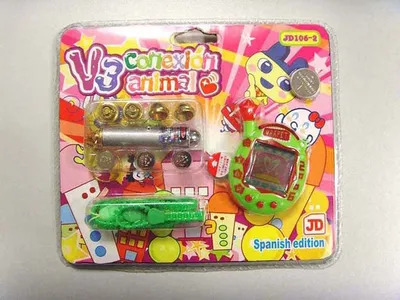
9 Llave Animal [Source] Description:
New member of infrared tamagotchi family, more advanced, convenient and interesting!
1. Adding six shortcut keys: Convenient operation and quickly go to the different option. The shortcut key is blinking once pressed. 2. Interactive game: Connecting with other infrared tamagotchi to exchange gifts, make friends, and even marry. 3. Vivid breeding process: Growth, marry requirement when getting mature and then give birth to a baby.
- New IC, new character installed. - New LCD, more than 1000 dots, the characters and pictrues are more clearer and vivider. - Gaining password after winning the game, inputting the password and get the secret gift.
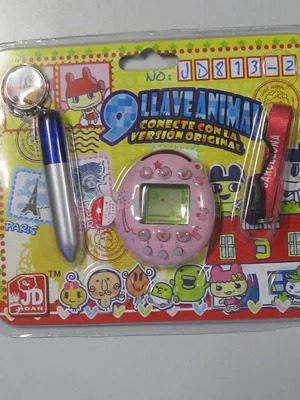
Infrared Tama Tamaschool [source] Description:
New member of infrared Tamagotchi family! More attractive, more smarter!
1. New shape, compack shape and touch screen operaton.
2. Class learning added, make the pet smarter and happier.
3. Interest: Has emotion, implys its master what to do and how to do; Lives as the similar way as human: Playing with and making friends with each other, choosing lovers when they grown up, and have their generation.
- New IC, new character installed. - New LCD, more than 1000 dots, the characters and pictrues are more clearer and vivider. - Gaining password after winning the game, inputting the password and get the secret gift.
4. Infrared connection with others to make friends and exchange gifs, enjoy the communication interest

Honey Lover [source] Description:
*heart shape behind the screen to blink during connection. *connect to the bandai V1& V2 &V3 infrared tamagotchi.
----New IC, new character installed. ----New LCD,clearer and vivider. ----Gaining password after winning the game, inputting the password and get the secret gift.
* install 1 piece CR2032 battery in stead of 2 pcs AG13 batter, its exhausing time would last much longer. *lovely couple package to save some money for client. *zipper attached make it easier to hand on. *manual has been translated into eight language. *newest paper card design.

Animal Imaginado [source] Description: New member of infrared tamagotchi family, more advanced, convenient and interesting! 1. Interactive game: Connecting with other infrared tamagotchi to exchange gifts, make friends, and even marry. 2. Vivid breeding process: Growth, marry requirement when getting mature and then give birth to a baby. 3. New IC, new character installed. Gaining password after winning the game or sucessfully infrared connection with others, inputting the password and get the secret gift. 4. Blinking function - when infrared connect, the inlayed heart would blink. 5. Durable battery: 1 piece CR2032, supporting long process than AG13. 6. Various packing and manual: English, France, Spanish German Portuguese, Italian etc. These worthful gift includes: --calculator --watch --clock --pedometer --counter --game console --laser pen --tamagotchi holder --tamagotchi bag

Azotea Tama [1][2] Description:
1. Wireless connection to exchange gift, make friend, and game compete with others.
2. Touch screen operation and get rid of all rubber keys, more convenient.
3. New IC, new character installed.
4. New LCD, more than 1000 dots, the characters and pictures are clearer and vivider.


Ura-Pet [Source] Description:
Our company is specializing in handheld electronic game, including infrared tamagotchi, sudoku game and icon game. Additionally, OEM is available.
New member of infrared tamagotchi family, more advanced, convenient and interesting!
1. Star model with lovely color. 2. Interactive game: Connecting with other infrared tamagotchi to exchange gifts, make friends, and even marry. 3. Vivid breeding process: Growth, marry requirement when getting mature and then give birth to a baby.

Mini Tamagotchi [Source] Description:
New member of infrared Tamagotchi family! More attractive, more smarter!
1. New shape, mini size
2. Non-infrared function
3. As an onament for key or mobile phone

Keyring Tama [source] Description:
April new item, new design, more funny, we belong to the FAMI-TAMA!
1. The latest V5 familitchi version 2. Lock model with cute key 3. House shape color card
Raise generations of families with proper care and feeding, Communicate with friends using the newest infrared capabilities, Characters can visit friends, play games and give gifts, even marry to having baby, Requires 1 "CR203" battery (not included), Having eight countries language color cards to choose.

Non-Tama Virtual Pets by Jidan:
Tedy Virtual Pet [Source] Description: 1.interesting breeding process to feed him, bath him, and discipline him. 2.good attention will make him grow up well. 3.game practice could bring you much fun.

GBA Bootlegs/Other Bootlegs by Jidan:
MnEIO (Mario GBA bootleg) [Source] Description: --Mario should fight with the dragon who shot the fire ball. --Player should accumulate the score to enter the next level.

Keroro Game [Source] Description: Keroro and his company should practice their fighting skill.

Keroro Fighting Game [Source] Description: Keroro and his company should practice their fighting skill. The stand at different side to strick back each other.

NaruIIto Fighting [Source] Description: 1.NaRudo and his companies will practice their fighting skill in this game. 2.Successful defense will earn one point for player. 3.Speed will increase and vary as score accumulated.

Dragonnumen [1][2] Description: -wireless connection to fight to enemy -pedometer to trace the process of adventure -crash card to vary the shape of digimon immediately


#bootleg#knockoffs#crappyoffbrands#fakies#bootleg tamagotchi#toy knockoffs#tamagotchi#chinagotchi#spamagotchi#Jidan#company#naruto#Mario#digimon#gba
6 notes
·
View notes
Text
Science and Nature - A One Health Perspective
With an open-ended blog prompt this week, I wanted to reflect on my evolving understanding of science as a means to understand our world’s issues. Science has always been an interest of mine. I’d always thought science was the key to understanding the world’s complex problems that we always hear about. Climate change, health crises, food insecurity, poverty, deforestation; I thought these issues could be solved with the proper understanding and application of science. We just needed to find those answers, and we needed scientific knowledge to do so.
I’m currently majoring in One Health, and by now, I have a good understanding of how interconnected human, animal, and environmental health truly are. Because of this, as much as I value science, I’ve also learned to recognize its limitations. The environmental crises we face today—from climate change to biodiversity loss—cannot be solved by scientific knowledge alone. We need holistic, multidisciplinary solutions that integrate different perspectives, including social, cultural, and ethical dimensions.
Of course, science provides essential tools for understanding and addressing environmental issues. It helps us monitor pollution, assess biodiversity loss, and develop conservation strategies. However, science often focuses on facts, data, and technological solutions, assuming that if people have the right information, they will act accordingly. Research on environmental education (EE) challenges this assumption, suggesting that people’s actions are influenced by broader worldviews, social structures, and belief systems—not just scientific facts (Wals et al., 2014). This pattern can be seen everywhere, and if you ask me, the state of the environment today makes this a more pressing issue than ever before. Ecosystems are collapsing, biodiversity is declining, and communities are facing worsening climate disasters and human health crises, yet many people—even those who hold an immense amount of power and influence in today’s society—refuse to accept and feel responsible for these crises because of the values they already hold. This means that simply presenting climate data to skeptics won’t necessarily change their minds, and as you can imagine, this makes it very difficult to instill lasting, sustainable change to mitigate these issues.
As I’ve learned throughout my degree, the most powerful way to ignite change is not just through facts and figures, but through shared values, storytelling, and hands-on experiences. One Health is an interdisciplinary field that recognizes the deep, inescapable ties between humans, animals, and the environment, embracing both scientific and non-scientific approaches to solving the world’s most pressing challenges. Take environmental education and citizen science, for example. These programs don’t just teach people about conservation; they invite them to be a part of it. They foster a sense of belonging, connection, and responsibility—transforming passive observers into active advocates of the world around them (Wals et al., 2014).

An example: Farmers planting trees in Tsavo, Kenya (IFAW, 2023)
I also believe in the undeniable power of early experiences in nature. Young people are the future of the planet, and if they grow up not only understanding nature but truly feeling a part of it, their love for the earth will shape the way they walk through the world. It will spark inspiration, curiosity, and ultimately, change. I’d like to end this post with a quote, which I think perfectly embodies the importance of education to inspire connection to nature:
“In the end, we will conserve only what we love; we will love only what we understand; and we will understand only what we are taught.” – Baba Dioum, Senegalese forestry engineer, 1968 in New Delhi at the General Assembly of the IUCN.
If we want a better future, we must start by inspiring the hearts and minds of those who will create it.
References:
Wals et al. (2014). Convergence between science and environmental education. Science, 344(6184), 583-584. https://doi.org/10.1126/science.1250515
International Fund for Animal Welfare (IFAW). (2023). Planting trees to safeguard elephant habitats in Tsavo, Kenya. https://www.ifaw.org/journal/planting-trees-elephant-habitats-tsavo
2 notes
·
View notes
Text
Greetings from New Imbrium, Omninet!
In days past, Systech Artificial Intelligence Solutions specialized in civilian- and factory-grade drones and assembly machines. However, in the more tumultuous times of recent years, the company has begun to produce combat-grade autonomous programs and mechanized equipment intended to be fielded alongside Union Lancers. Thanks to a partnership with an external contractor's Special Materials Research Division, SAIS has taken their unique style of virtual intelligences and redeveloped them for the theater of war.
-----
Systech Artificial Intelligence Solutions values the voices of our clientele. As such, we've decided a wider presence on the Omninet was in order to make sure those voices are heard.
This page serves as a socialport for the company, allowing you all to ask us questions about our products directly. Whether it's a query about our novel CA-VIs and their accompanying frames, a worrying concern, or simply feedback; we welcome your voice.
"To see a new future, together."
------
Howdy! This is a RP blog run by @tiredarts-main for my homebrew Lancer TTRPG foundry, SAIS!
Interested in getting your hands on some SAIS tech? Follow the project on itch.io here: https://tiredarts.itch.io/lancer-sais
Despite the name, nothing here is AI-generated. SAIS is a fictional foundry.
Links are highlighted in blue whenever possible, and every post is tagged appropriately if it contains sensitive material. Don't hesitate to reach out if something needs a tag- I'm only human(ish), after all!
#lancerrpg#lancer rpg#lancer ttrpg#lancer rp#ooc talk below readmore#pr talks#lancer homebrew#sais lancer
5 notes
·
View notes